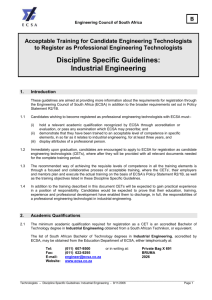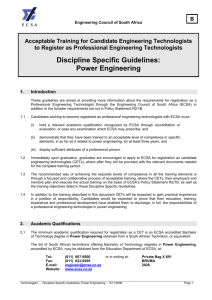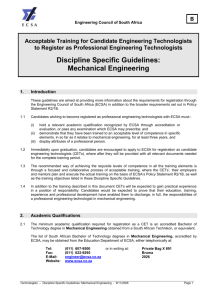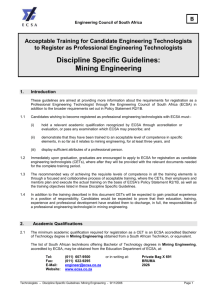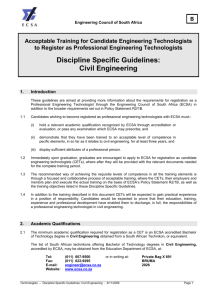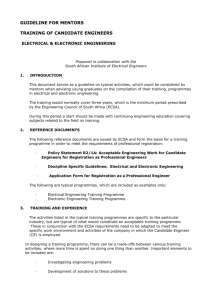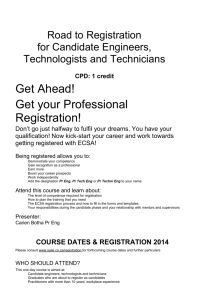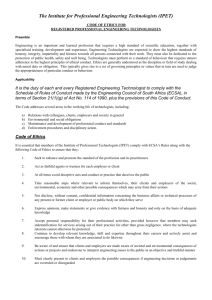Electronic and Telecommunications Engineering
advertisement
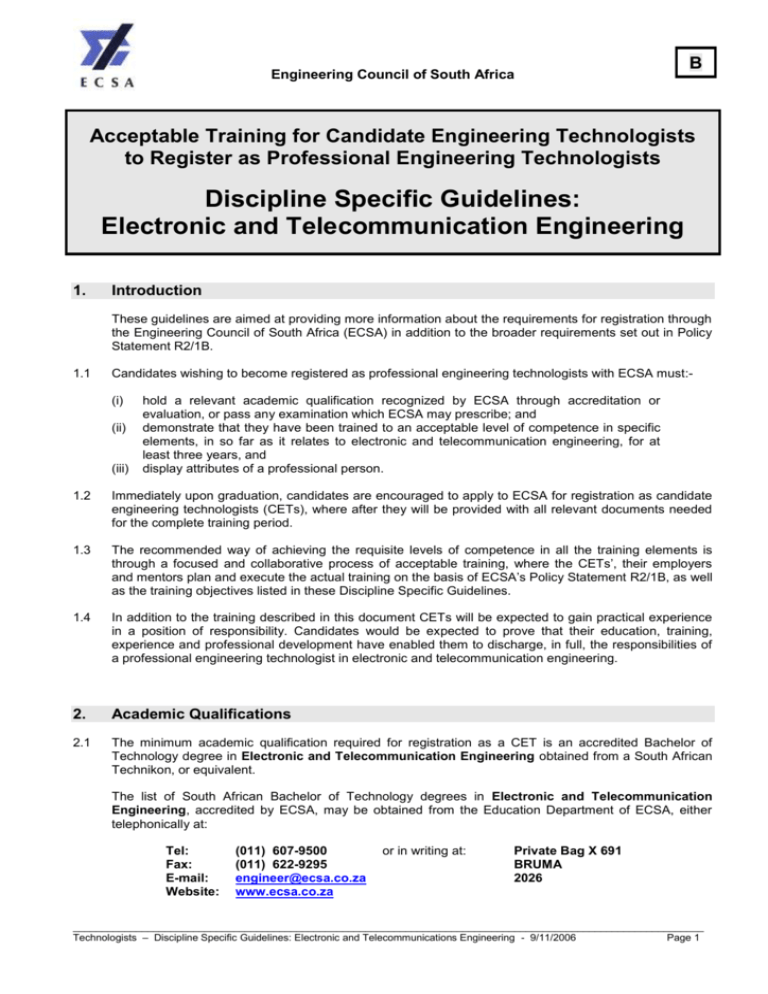
Engineering Council of South Africa B Acceptable Training for Candidate Engineering Technologists to Register as Professional Engineering Technologists Discipline Specific Guidelines: Electronic and Telecommunication Engineering 1. Introduction These guidelines are aimed at providing more information about the requirements for registration through the Engineering Council of South Africa (ECSA) in addition to the broader requirements set out in Policy Statement R2/1B. 1.1 Candidates wishing to become registered as professional engineering technologists with ECSA must:(i) (ii) (iii) hold a relevant academic qualification recognized by ECSA through accreditation or evaluation, or pass any examination which ECSA may prescribe; and demonstrate that they have been trained to an acceptable level of competence in specific elements, in so far as it relates to electronic and telecommunication engineering, for at least three years, and display attributes of a professional person. 1.2 Immediately upon graduation, candidates are encouraged to apply to ECSA for registration as candidate engineering technologists (CETs), where after they will be provided with all relevant documents needed for the complete training period. 1.3 The recommended way of achieving the requisite levels of competence in all the training elements is through a focused and collaborative process of acceptable training, where the CETs’, their employers and mentors plan and execute the actual training on the basis of ECSA’s Policy Statement R2/1B, as well as the training objectives listed in these Discipline Specific Guidelines. 1.4 In addition to the training described in this document CETs will be expected to gain practical experience in a position of responsibility. Candidates would be expected to prove that their education, training, experience and professional development have enabled them to discharge, in full, the responsibilities of a professional engineering technologist in electronic and telecommunication engineering. 2. Academic Qualifications 2.1 The minimum academic qualification required for registration as a CET is an accredited Bachelor of Technology degree in Electronic and Telecommunication Engineering obtained from a South African Technikon, or equivalent. The list of South African Bachelor of Technology degrees in Electronic and Telecommunication Engineering, accredited by ECSA, may be obtained from the Education Department of ECSA, either telephonically at: Tel: Fax: E-mail: Website: (011) 607-9500 (011) 622-9295 engineer@ecsa.co.za www.ecsa.co.za or in writing at: Private Bag X 691 BRUMA 2026 ______________________________________________________________________________________________________________ Technologists – Discipline Specific Guidelines: Electronic and Telecommunications Engineering - 9/11/2006 Page 1 2.2 Persons who have graduated from a technikon, university or any other institution not specifically accredited by ECSA, and who wish to apply for registration as CETs, must apply to ECSA for evaluation of their qualifications. If their qualifications are evaluated to be at least equivalent to an accredited South African qualification, candidates will be eligible for registration as CETs and could then follow the normal route to registration as professional engineering technologists. 2.3 Persons whose qualifications are not accredited or recognized by ECSA may follow an alternative route to meet the academic requirements for registration as CETs. Candidates must apply to ECSA and obtain the necessary information on the procedure to be followed. 2.4 Those who meet ECSA’s academic requirements should register as CETs without delay. Application forms can be obtained from ECSA. CETs must, from the outset, also obtain copies of the application form for registration as professional engineering technologists. 3. Training and Professional Development under a Commitment and Undertaking (CU), and Mentorship Commitment and Undertaking (CU) 3.1 CETs must persuade their employers to register a Commitment and Undertaking with ECSA, namely that they will structure the training of, and actually train, their CETs, in accordance with the requirements of ECSA’s Policy Statement R2/1B as well as the requirements set out in these Discipline Specific Guidelines. Each CU will be allocated a permanent registration number, which should be quoted by all CETs when applying for registration as professional engineering technologists. 3.2 Employers must, at the same time, submit the name(s) of a mentor(s) from within the organization (see § 3.4 below) or, if an internal mentor is not available, the name of an external mentor (see § 3.5 below) to guide CETs through the required process of training. A CU will not be registered by ECSA unless the name of at least one mentor (internal or external) is provided. Mentorship and Supervision 3.3 ECSA, the South African Institution of Electrical Engineers (SAIEE), the South African Institute of Measurement and Control (SAIMC) and the Institute of Professional Engineering Technologist (IPET) will maintain a list of internal and external mentors. A mentor must be registered as a professional engineer or a professional engineering technologist. Council will only in exceptional cases consider the listing of experienced and mature professional certificated engineers, or professional engineering technicians, upon application and motivation by the organization/mentor concerned. These mentors will be deemed not only to be capable of fulfilling their functions in a professional manner but also as being committed to advising and guiding their CETs in their professional development. 3.4 It is STRONGLY RECOMMENDED that all CETs should have a mentor who is working in the same organization as the CETs i.e. an internal mentor. 3.5 It will be expected of employers who make use of the services of external mentors to create an environment in which such mentors can feel free to make recommendations in the reasonable knowledge that their recommendations will be given sympathetic consideration. 3.6 It will be expected of all mentors to become fully conversant with their functions and responsibilities referred to in Policy Statement R2/1B and guidelines issued by ECSA from time to time, to conduct regular discussions with their CETs and to assess their progress in accordance with the guidelines set out in Policy Statement R2/1B and these Discipline Specific Guidelines. Since the effectiveness of mentors will continuously be monitored, Council will attach much value to the opinion of “the conscientious mentor” as to the registrability (or otherwise) of their CETs. 3.7 It is not expected of mentors to take responsibility for the day-to-day supervision and training of CETs. Mentors/employers should do everything in their power to ensure that competent persons, preferably registered with ECSA, are available to oversee this function as supervisors. ______________________________________________________________________________________________________________ Technologists – Discipline Specific Guidelines: Electronic and Telecommunications Engineering - 9/11/2006 Page 2 4. General 4.1 Training reports, together with project summary reports, form an essential part of the monitoring process and must be updated regularly and be submitted at the time of application as a professional engineering technologist. These forms are part of the application form, which should be obtained from ECSA as soon as the CET’s start their training. 4.2 It is a requirement that CETs who are aspiring to become professional engineering technologists should, with the assistance of their mentors, achieve their training objectives by structuring their training in such a way as to cover the various elements of training referred to in Policy Statement R2/1B and these Discipline Specific Guidelines. 4.3 The rate at which CETs progress through their training is determined by themselves, their mentors and other factors, such as the state of the economy and availability of training opportunities. During the nominal three-year training period the CET must from time to time self evaluate his/her progress in achieving planned objectives and goals if enhanced levels of engineering practice and increased levels of responsibility in the workplace are to be achieved. Any lack of impedance of such progress should be disclosed with an internal or external mentor. 4.4 Where CETs, training under a CU to decide to change employers, they should ensure that they continue their training under another CU registered by their new employers. CETs should also ensure that their new employers provide mentors to guide them through the remainder of their training period and to take over where the previous mentor ended. It may even be advisable to retain the previous mentor, if this is at all practicable. 4.5 Once all the objectives have been achieved to the satisfaction of the mentor, CETs should, in principle be registerable, and could then apply for registration as professional engineering technologists. Depending on the circumstances, CETs may expect to take a minimum of three years to achieve acceptable competence in all the prescribed elements. However, Council has found that it invariably take longer than the minimum of three years training to obtain the appropriate level of experience and engineering responsibility hence candidates are advised to only apply when they are comfortable with their engineering experience and responsibility to function as a professional engineering technologist. 4.6 Regardless of whether or not CETs train under a CU, it is recommended that they strive to participate in a process of continuing learning. This concept includes continuing education and professional development. 4.7 Continuing learning may include attending courses, technical conferences, seminars, symposia, organized site visits, and meetings of professional bodies, and self-study. The process of continuing learning should achieve a balance between engineering and managerial/professional aspects. In this respect the CETs should take a basic course in economics and cost and works accountancy, which will assist the CET to assume a managerial position. 4.8 The mentors of CETs should, on a consultative basis, suggest suitable continuing learning programmes. 4.9 SAIEE, SAIMC, IPET and educational institutions may be able to assist in advising on courses, which are available. 4.10 It will be to the advantage of CETs when applying for registration as professional engineering technologists if they can demonstrate their participation in a process of continuing learning. 5. Professional Attributes The following attributes are considered common to all professional engineering technologists and the requirements for these attributes are designed to ensure that CETs acquire competence with respect to professional responsibility in decision making, engineering judgement, communication and an appreciation of their own professional and working environments. ______________________________________________________________________________________________________________ Technologists – Discipline Specific Guidelines: Electronic and Telecommunications Engineering - 9/11/2006 Page 3 5.1 Professional Responsibility CETs must ensure that their work reaches a level of responsibility commensurate with that which ECSA would normally expect of an engineering technologist with a period post graduate experience, both in terms of the type and level of work being performed. This means that responsibility for directing personnel, money and materials must be taken during the execution of a project or part of a project. When applying for registration as a professional engineering technologist, CETs must demonstrate their ability to work satisfactorily on their own, that they have taken responsibility and, in having done so, achieved a satisfactory outcome. However, the CET must always take cognizance of the fact that the safety of the public is paramount. It is, therefore, obligatory for the CET not to undertake the design, directing, or supervision of any project that entails work that extends beyond the scope of the experience and knowledge that the CET has acquired during his/her training, particularly if such work may be a threat to the public’s safety. In such a case the CET should call on the services of a registered practitioner who has the necessary experience to supervise such work. 5.2 Engineering Judgement displayed in Practical Application When applying for registration as a professional engineering technologist, CETs must demonstrate that their engineering work required them to – 5.3 exercise independent engineering judgement, combining their experience and application of engineering principles; accept responsibility for such decisions; and understand and take into account financial, economic, commercial and statutory considerations. Communication Skills CETs must develop the ability to communicate lucidly, accurately and with confidence. ECSA will base its assessment of a CET’s communication skills on the quality of the application presented. 5.4 Professional Environment 5.4.1 CETs must, when reporting to their mentors on a regular basis, and in discussions with them, demonstrate that they have: a general understanding of engineering procedures applicable to their engineering discipline; a general knowledge of legislation which has a bearing on the practice of engineering in South Africa, with a detailed knowledge of the important sections of the Engineering Profession Act, 2000 (Act No 46 of 2000) and the Acts and Regulations applicable to their specific engineering discipline; and understanding of the Code of Conduct applicable to registered persons; an understanding of the purpose of and relationship between the various organisations involved in their engineering discipline and full familiarity with the requirements for registration set out in Policy Statement R2/1B as well as these Discipline Specific Guidelines. ______________________________________________________________________________________________________________ Technologists – Discipline Specific Guidelines: Electronic and Telecommunications Engineering - 9/11/2006 Page 4 5.4.2 Membership of a Professional Engineering Society will be advantageous to the candidate and credit will be awarded at the time of application for registration as a professional engineering technologist. 6. Discipline Specific Elements Since the field of employment for graduate electronic and telecommunication technologists covers a wide spectrum, it would be illogical to expect all training programmes to be alike. Electronic engineering typically covers areas such as electronics, telecommunications, radio systems, micro processor and computer systems (hardware as well as software), instrumentation, digital and analogue control systems, process control systems, broadcasting, satellite earth stations, antenna arrays and a wide range of signaling systems. 6.1 The following elements cover the technical field which graduates must be exposed to when training for registration as professional engineering technologists: Design of analogue and digital equipment or systems Commissioning of equipment or systems Maintenance principles Development of products Reporting Management The CET’s should record their personal contributions in these activities. 6.1.1 In designing and modification of existing equipment, the CET must show evidence of adequate training in this function and verifiable work carried out in the analysis of a problem and in the synthesis of a solution. Evidence in the form of a report, certified by the supervisor, of a completed design is required to indicate that applicants have had an opportunity to apply their technical knowledge gained through academic training in the design process. The work must also show evidence of engineering judgement. 6.1.2 In commissioning of equipment or systems, the CET must demonstrate an understanding of the engineering concepts utilized in the system, how the equipment functions, the reason why the equipment was acquired and the impact this will have in the business. 6.1.3 In the maintenance environment, the CET must demonstrate what engineering and financial implications are involved, why the equipment is maintained at the prescribed intervals and what tests have to be done to verify the proper functioning of the equipment before recommissioning. 6.1.4 In developing a product, the CET must indicate why the development is undertaken, what literature studies were done, show alternative options, demonstrate the application of engineering principles, discuss the advantages of the chosen approach, discuss the manufacturing implications of the product and report in the outcome of the project. If the development is not successful, it is not necessarily regarded as a failure. 6.1.5 In response to a specific engineering brief, or a solution to a problem, the CET must present a report in an appropriate fashion which would include an executive summary, followed by a properly structured technical report comprising of text, diagrams, sketches, charts, general arrangement drawings and computer related documentation where applicable. The CET must demonstrate communication and presentation skills as well as a professional approach to the problem. 6.1.6 The work of a professional engineering technologist includes the integration of technical knowledge with control of manpower, finance and time management. It is, therefore, important that the CET is exposed to these aspects and can demonstrate that they have increasingly applied these management principles throughout their training period. As they progress through their training period, graduates must be given increasing responsibility for the independent execution of engineering work. Applicants must satisfy ECSA that they have been able to deal adequately with such increased responsibility by having taken significant control of projects. ______________________________________________________________________________________________________________ Technologists – Discipline Specific Guidelines: Electronic and Telecommunications Engineering - 9/11/2006 Page 5 Form B2.3 Project Summary Report: Candidate Engineering Technologist Use this form to report on a project to which you have made a significant contribution. Use a new form for each project. At least one but not more than three projects should be submitted. Name: _______________________________________________________________________________ Candidate Reference No: ______________________________________________ Project name and dates Engineering brief and objective Environment (Industry; Laboratory; Theory: Simulation) Summary (State engineering problems; solutions) Your contribution to the project (State aspects of engineering judgement) Title of Report or Publication Budget Signature of Candidate: ___________________________________ Date: _________________________ Signature of Mentor: _____________________________________ Date: _________________________ ______________________________________________________________________________________________________________ Technologists – Discipline Specific Guidelines: Electronic and Telecommunications Engineering - 9/11/2006 Page 6
